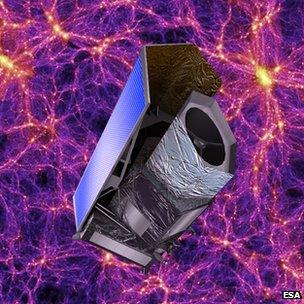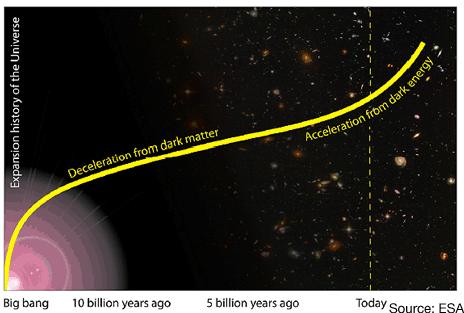Euclid spacecraft to be built by Thales Alenia Space
- Published

Euclid will conduct its surveys 1.5 million kilometres from Earth on its "night side"
The European Space Agency (Esa) has appointed Thales Alenia Space (TAS) of Italy to lead the construction of its "dark explorer", Euclid.
The organisation's Industrial Policy Committee has approved the issuing of a contract worth 322m euros (£275m).
Euclid will launch in 2020 and look deep into the cosmos for clues to the nature of dark energy and dark matter.
These phenomena dominate the Universe, and yet scientists concede they know virtually nothing about them.
"Euclid will be so impressive; it will be a cosmologist's dream, and we are making it happen step by step," Prof Alvaro Gimenez, Esa's director of science, told BBC News.
The TAS contract, which will be signed in the coming weeks, completes the sourcing of the two major elements that make up Euclid.
A contract to build the payload module, which will hold the 1.2m telescope and two instruments, has already been awarded to Europe's other big space company, Astrium.
Its value, some 72m euros, will come out of the global sum that will now go to TAS as prime contractor.
Thales Alenia's job will be to direct the industrial project, constructing the spacecraft's basic structure and then integrating all other parts.
As is often the case with Esa science missions, the instruments will be delivered direct, and paid for, by individual member states.
Euclid will make its observations using a visible-light camera from the UK and a near-infrared camera/spectrometer from France.
The latter needs particular detectors that will be acquired from a US specialist, Teledyne.
"As you know, we will be paying for the development of the infrared detectors but it is Nasa who will pay for the flight models," said Prof Gimenez.
By picking up this bill, in the region of 30m euros, the US space agency is effectively buying positions in the Euclid science consortium for 40 American researchers.
Distorted view
Dark energy and dark matter are two of the most pressing problems in science.
Together, they account for about 95% of the energy density in the cosmos, but researchers are nowhere near a description for either.
Dark energy is the name given to the "force" that appears to be driving the Universe apart at an accelerating rate.
Dark matter is the extra material that is unseen but which astronomers know to be there because of its gravitational effects on the matter we can observe. Galaxies, for example, could not hold their shape were it not for the presence of some additional "scaffolding".
Euclid will try to plot dark matter's distribution by looking for the subtle way its mass distorts the light coming from distant galaxies. It will do this over a third of the sky.
The mission will go after dark energy by mapping the three-dimensional distribution of galaxies. The patterns in the great voids that exist between these objects can be used as a kind of "yardstick" to measure the expansion through time.
Ground-based surveys have done this for small volumes of the sky; Euclid however will measure the precise positions of some two billion galaxies out to about 10 billion light-years from Earth.
And American involvement raises the prospect of an additional method being used to study dark energy. Many US scientists have used exploding stars, or supernovae, as the distance measure instead of galaxies. Euclid would be well equipped to try this approach also.
"It could happen. It would be a bonus, but first we intend to measure the galaxies to get at dark energy," Prof Gimenez told BBC News.
Euclid will launch on a Soyuz rocket and make its observations at a position about 1.5 million km from Earth.
Esa expects its total expenditure over the lifetime of the project to be just over 600m euros.

Jonathan.Amos-INTERNET@bbc.co.uk and follow me on Twitter: @BBCAmos, external
- Published20 June 2012
- Published26 April 2012
- Published31 March 2012
- Published5 October 2011
- Published4 October 2011
- Published4 October 2011